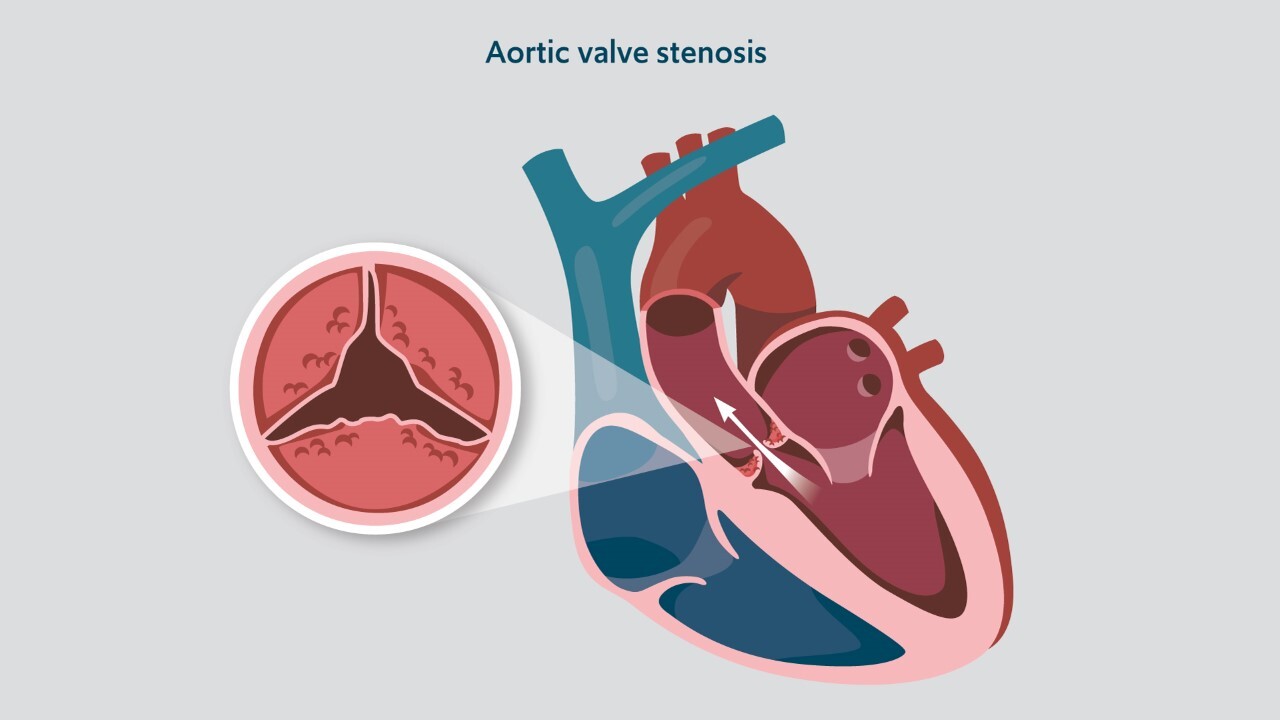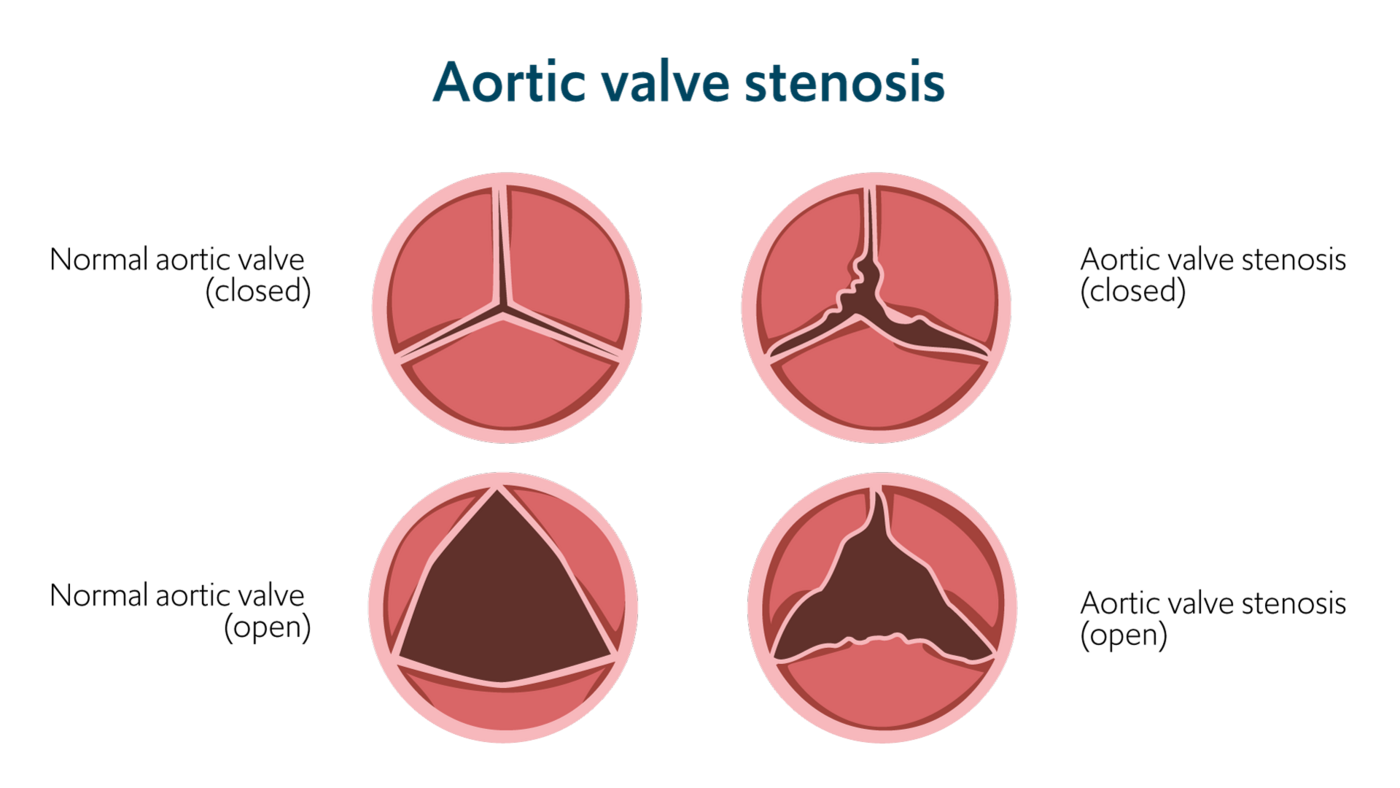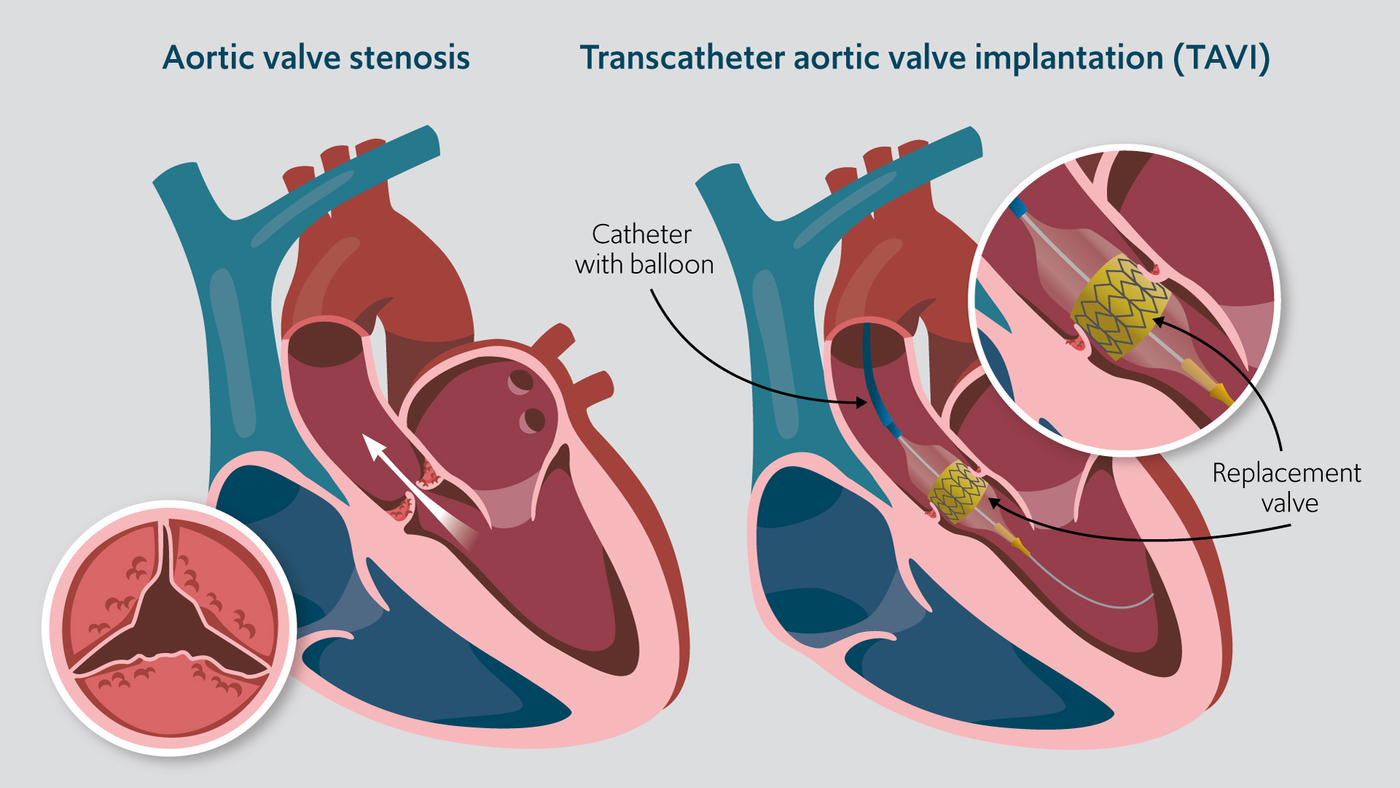What is aortic stenosis?
Aortic stenosis is a disease that affects the main outlet valve of the heart and is the third most common cardiovascular disease. The condition involves the narrowing of the aortic valve, which is one of the four heart valves. Aortic stenosis disrupts the blood flow to the aorta (the body’s main artery) from the heart’s left chamber.
Because it causes the heart to pump blood harder through the narrowed aortic valve, aortic stenosis can weaken and enlarge the left ventricle of the heart. This can potentially lead to heart failure if not treated. The condition is more common in older adults, affecting 20% of people aged over 65.

Aortic valve stenosis is a condition in which the aortic valve narrows, reducing blood flow.
Aortic stenosis symptoms
Aortic stenosis is classed as mild, moderate or severe. Symptoms usually present themselves when aortic stenosis is severe. You may have had aortic stenosis for many years and not experience any symptoms.
Symptoms may include:
- chest pain (angina)
- heart murmur (a ‘whooshing’ or blowing sound heard via a stethoscope)
- shortness of breath (particularly with activity)
- fatigue
- dizziness
- fainting
- heart palpitations (pounding or fluttering heart)
- not eating enough or not gaining enough weight (usually in children with the condition)
If you develop symptoms which may indicate aortic stenosis, make an appointment with your doctor.
What causes aortic stenosis?
The aortic valve is one of four valves in the heart that keep blood flowing correctly. The aortic, mitral, pulmonary and tricuspid valves all have cusps (flaps of tissue) that open and close with each heartbeat. When valves can’t open fully, blood flow is reduced.
Causes of aortic stenosis – when the aortic valve between the left ventricle and aorta narrows and can’t open properly – include:
- calcium build-up (aortic valve calcification)
- congenital heart defect (children may be born with an aortic valve that has two cusps instead of three)
- rheumatic fever (a condition that can involve the valves of the heart)
You may be at more risk of getting aortic stenosis if you:
- are aged 65 or older
- have a congenital heart condition (a heart condition present from birth)
- have chronic kidney disease
- have diabetes
- have high cholesterol
- have high blood pressure
- have undergone radiation therapy to your chest
- have had infections that affect the heart (including rheumatic fever)

Aortic valve stenosis
Aortic stenosis complications
There are certain complications of aortic stenosis which may arise if the condition is not treated. These include:
- stroke
- heart failure
- arrhythmias (irregular heartbeat)
- bleeding
- blood clots
- infections which may affect the heart (including endocarditis and pericarditis)
- sudden death (in rare cases)
Diagnosing aortic stenosis
Initially, your healthcare provider will ask you questions about your symptoms, review your medical history, and listen to your heart with a stethoscope.
Several heart tests can be used to diagnose aortic stenosis, including:
- echocardiogram (echo)
- electrocardiogram (ECG or EKG)
- exercise stress test
- chest X-ray
- computerised tomography (CT) scan
- magnetic resonance imaging (MRI) scan
Aortic stenosis treatment
There are several treatments available for aortic stenosis. The most suitable treatment for you will depend on the nature of your symptoms, the severity of the conditions, and your age.
If you are in the early stages of aortic stenosis or have mild symptoms, you may only need regular check-ups to monitor your condition, along with making lifestyle changes or taking medication to reduce the risk of complications.
However, we may request surgery if the severity and symptoms warrant it.
Aortic valve replacement
Aortic valve replacement involves the removal of the damaged valve, which is replaced with a new mechanical or biological tissue valve. Aortic valve replacement is recommended when aortic stenosis symptoms become severe.
The procedure involves an incision being made in the chest to access the heart. Your heart is stopped and a bypass machine is used to pump blood. The damaged valve is taken out and replaced with a new valve.
You’ll discuss whether your replacement valve will be mechanical (synthetic) or biological (from animal tissue) with your doctor.
TAVI procedure
Transcatheter aortic valve implantation (TAVI) is a minimally invasive surgical procedure that inserts a new aortic valve into the heart. TAVI is indicated for patients at high and intermediate surgical risk and can be an alternative to surgical AVR for those at low risk.
The procedure requires IV administration of a sedative and medication to avoid blood clots. TAVI is done using small incisions and a catheter (thin tube) to access the heart, guided by X-ray images. The replacement biological valve is passed through the catheter and placed in the aortic valve area, where it is positioned and secured.

TAVI treats aortic stenosis by placing a replacement valve into the aortic valve area via a catheter.
Balloon valvuloplasty
Balloon valvuloplasty – also known as BAV (balloon aortic valvuloplasty) – is a minimally-invasive procedure that can improve the symptoms of aortic stenosis. It stretches the aortic valve and helps to improve blood flow through the heart. A balloon valvuloplasty can be recommended for patients before an aortic valve replacement, TAVI or another form of heart surgery, as it enhances implantation. Sometimes BAV is also used for patients who are at too high risk for AVR or TAVI.
The procedure is done with a catheter which is inserted into the groin and guided to the heart using an X-ray. It uses an inflated balloon to open up the valve and increase blood flow.
Locations
Discover our cardiology experts
Meet our team of cardiologists specialising in aortic stenosis. Whether it’s maintaining heart health or implementing innovative interventions, our experts are here to offer personalised care tailored just for you.
